Life Jacket Logic: Wear one for Life
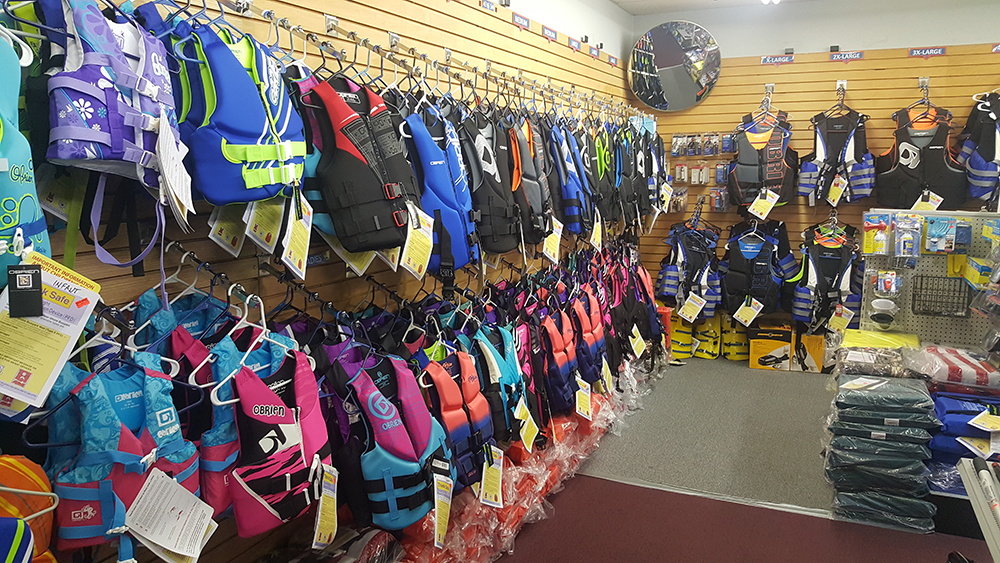
Why Do I Need to Wear a Life Jacket?
The statistics from the US Army Corps of Engineers sign (below) are alarming, and sobering. First, the sign highlights the dangers inherent with activities in, on, or near the water. Second, the role of the life jacket in saving lives is beyond question. Maintaining a healthy awareness of the risks of boating and best practices for safety will go a long way in protecting you and the ones you love. A great way to maximize your enjoyment while lowering your risk is to complete a boater education course. (For more information about boater education, check out our Boater Resources page.) Short of that, a PFD is the most important element of your safety resources.
However, and under even the best conditions, accidents happen and the unthinkable can take place. Having and wearing a properly fitting life jacket, life vest, or PFD (personal flotation device) is your best defense against you becoming the next statistic.
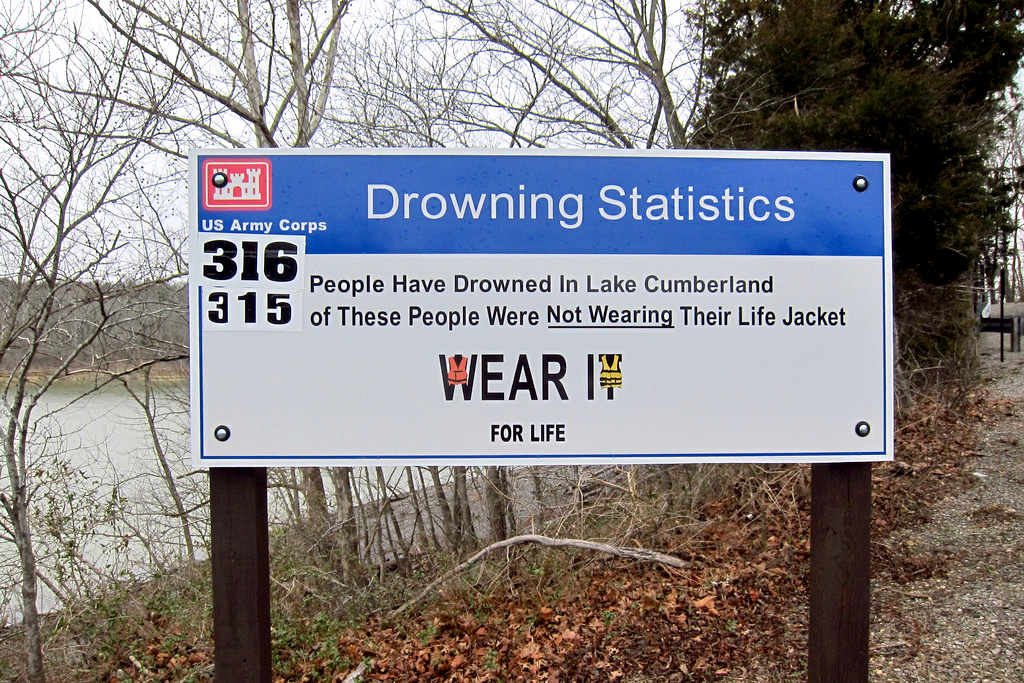
How Do I Choose a Life Vest?
Just as there are a multitude of ways to enjoy the water, so are there are a variety of life jackets and life vests available to choose from. The United States Coast Guard (USCG) categorizes PFD’s according to various types. Stokley’s Marine Accessories Manager, Michael Foster, brings a wealth of safety knowledge to the boating scene, and explains that each type offers certain advantages and disadvantages based on the specific use and needs of the wearer. Here is a listing of those types.
- Type I PFD—Off-Shore Life Jacket
These devices are meant for open water where conditions can be rough and rescue can be delayed. They provide the highest level of flotation, are highly visible in color, and will turn most wearers face-up in the water, which is especially important in the event that the wearer becomes unconscious. The main disadvantage is their size: they can be very large, bulky, and hot.
- Type II PFD—Near-Shore Buoyant Vest
Like Type I PFD’s, Type II devices can turn a wearer face-up in some circumstances, but with less reliability than a Type I device. They tend to be less bulky and more comfortable to wear, but are not designed for extended time in rough, open water.
- Type III PFD—Flotation Aid
Most Kentucky boaters are likely to have these kinds of flotation devices on board. Type III PFD’s come in a variety of styles (ranging from vests to coats) and are designed for a number of applications. They tend to be more comfortable than Type I and II devices, but do not provide the same level of protection for extended exposure in rough seas, especially where waves might cover the wearer’s face. In addition, Type III PFD’s are less likely to turn an unconscious wearer face-up: the wearer may have to tilt his or her head back to avoid going face down.
- Type IV PFD—Throwable Device
All boats must carry a Coast Guard-approved, Type I, II, or III life jacket for each passenger on board. Boats that are 16 feet in length and greater, excluding canoes and kayaks, must ALSO carry one, Type IV throwable flotation device (such as a life ring or seat cushion).
Type IV devices are intended for calmer, inland waters where boat traffic is more regular and help is always nearby. Often taking the shape of a life ring or a square cushion, throwable devices make for good secondary flotation when thrown to an immersed person wearing a lifejacket. A good strategy for a seat cushion PFD is to have the person in distress place his or her arms through the straps so as to hold the cushion close to the person’s chest. This will not only increase the person’s buoyancy but can also help to keep the victim’s face up.
However, this type of PFD should never be secured to a boat or any object in such a way as to limit one’s ability to quickly and accurately throw it to a person in distress. While Type IV PFD’s are convenient (they can even be used as seat cushions), they should not be used as primary flotation for non-swimmers or children. Likewise, they are of little or no use to an unconscious victim.
- Type V—Special Use Devices
There are a number of special use PFD’s designed for specific applications, including boardsailing vests, deck suits, work vests, hybrid PFD’s, and more. Some of these are tailored to very specific activities, like water skiing, canoeing and kayaking, standup paddle boarding, and sailing. Here is a list of some of the more common, special-use flotation devices:
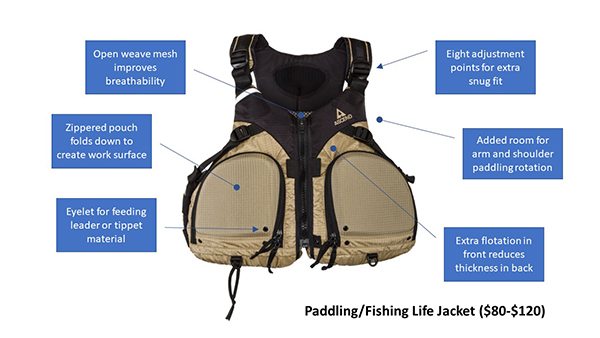
A fishing life jacket combines comfort and function. Open-weave mesh circulates air, making these vests quite cool, while pockets and pouches provide plenty of storage space for snacks, gear, and tackle.
A fishing life jacket tends to have more flotation along the lower part of the jacket and often includes pockets and lash points for tackle and tools. Nylon tends to be the material of choice since it is a bit looser fitting and breathable, making for a more comfortable experience when simply boating or fishing. However, and because of the looser fit, nylon can be slippery enough to ride up over the head and neck of the wearer, so sizing and fit are critical (see below). Performance fishing life vests offer additional features. These may include a crotch-strap for extra security in the event of a high-speed ejection from the boat and a flotation collar to help turn the wearer face-up in the water.
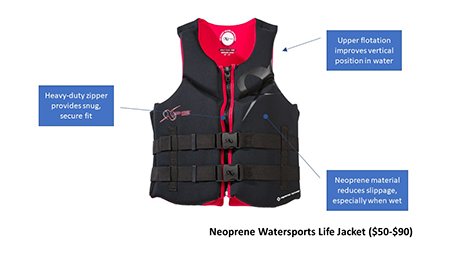
A neoprene ski vest fits snugly with minimal slippage. Perfect for all kinds of watersports, including skiing, wake boarding, kneeboarding, and wake surfing.
Watersports life vests are typically made of neoprene, which fits snugly (especially when wet). However, these close-fitting vests can be a bit uncomfortable in the heat of the day, and no one knows this more than a child. Accessories Manager, Michael Foster, offers a great tip concerning neoprene ski vests: “A t-shirt worn under the vest can not only help cut down on sunburn but can also help keep its wearer from overheating if water from the lake or cooler is poured around the neck and allowed to wick down the torso. Children under twelve required to wear the vest on the water can be cooled down a bit on a very hot day, making the time forced to spend with the family less heated!”
A kayak life vest is specially designed to provide greater movement around the arms and shoulders for paddling. They have less flotation in the back (to accommodate a seatback) and more in the front. In addition, they often have more mesh to allow for enhanced air circulation given the more strenuous nature of paddle sports. Numerous points of adjustment assure a solid, secure fit, and a myriad of functional features make fishing from a kayak easier and more enjoyable.
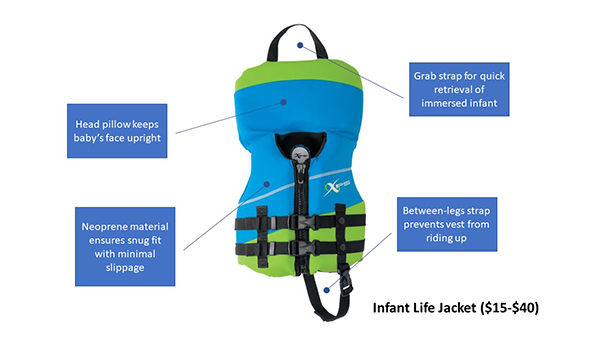
Life jackets for babies and toddlers provide maximum safety and security, including head pillows and between-legs straps.
An infant life jacket typically features an additional flotation collar at the back of the neck that helps keep the baby’s head above water. They also feature a strap that goes between the infant’s legs, providing maximum protection against the risk of the device riding up over the child’s head and neck.
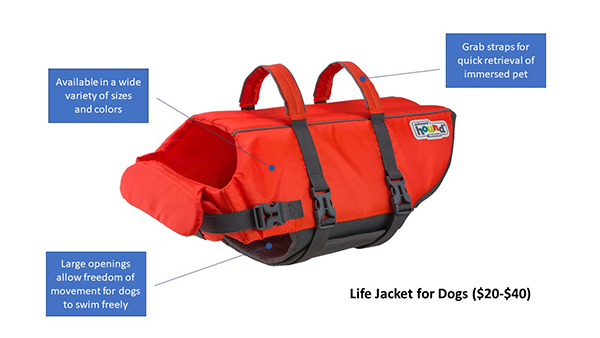
Life jackets for dogs come in a variety of sizes to ensure a proper fit for your pet.
Looking for a dog life jacket? They are available in a surprising number of sizes and colors. These devices provide ample flotation without hindering your pet’s ability to swim and walk freely. They typically feature one or two straps so that a wet pooch can be safely and comfortably brought back on board your boat. At Stokley’s Marine, we have dedicated a section of our accessories store to your pet’s needs, and a large selection of doggie life jackets IS available year-round in our store.
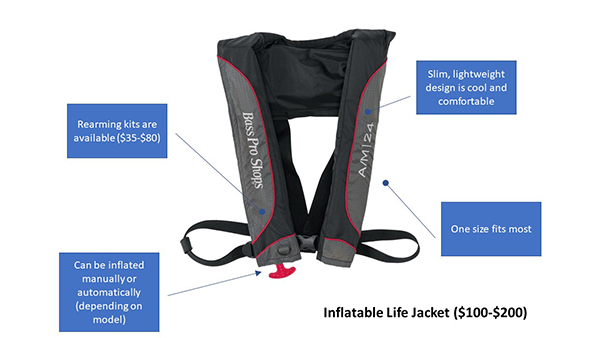
An inflatable life jacket is the lightest-weight, most comfortable option for most boaters. They come in manual or manual/automatic models, and re-arming kits are readily available after an inflatable vest has been deployed.
Inflatable life jacket. An increasingly popular choice among the Type V PFD varieties is the inflatable type. These are the least bulky of all PFD types and offer comfortable, low-profile, lightweight designs. They also provide high flotation when inflated and are well-suited for continuous wear—even in extreme heat. Inflatable life jackets inflate when a CO2 cartridge is discharged, filling the PFD bladder with pressurized air. The vest can be inflated manually by pulling on a handle that resembles a parachute rip cord. Alternately, they can be inflated automatically when a sensor detects water pressure. Rain will not typically deploy an inflatable PFD; the sensor must be submerged briefly to discharge the cartridge. A third option should the first two fail is for the wearer to inflate the device with the back-up oral inflation valve.
These inflatable life jackets do have their drawbacks, though. For starters, you can expect to pay much more for one of these versus a conventional Type I, II, or III device. Second, they are not intended for persons below 16 years of age or less than 80 lbs. Third, and like a Type IV throwable device, they are not meant for non-swimmers or weak swimmers. Fourth, they do require maintenance. Any time an inflatable life jacket is deployed, it must be re-armed. Although re-arming kits are readily available, they do add another layer of expense, especially if owners may not be comfortable re-arming themselves. (Accessories Michael is an expert at re-arming inflatable vests and is always available to assist our customers.)
Another drawback pertains to travel by air: airlines will likely take a dim view of CO2 cartridges on board their commercial flights, so you may have to leave this type of life vest at home for your next fishing trip to Florida. (Always be sure to check with your airline or the Transportation Security Administration’s guidelines.)
What Do I Need to be Legal on the Water?
Although laws and regulations vary from state to state, the Kentucky Department of Fish & Wildlife publishes their annual Fishing and Boating Guide. This guide includes regulations pertinent to Kentucky boaters. Among these you will find the following:
- A properly-fitting, serviceable Type I, II, or III lifejacket is required for every person on board a boat. If an inflatable lifejacket or lifevest is employed, it must be worn.
- Operators of and persons riding a personal watercraft must be wearing a PFD.
- Persons less than twelve years of age must wear a properly-fitting lifejacket while in the open portion of a boat that is under way.
- And as mentioned above, vessels 16’ and longer (except for canoes and kayaks) require a throwable, Type IV device.
In addition, Kentucky requires that all personal flotation devices must be:
- Approved by the USCG. Each approved device will be stamped or labeled with an approval number.
- Serviceable. This means that the PFD is free of rips and tears. The straps, buckles, zippers, and stitching must be intact, and the fabric should show no indication of dry rot, excessive fading due to UV rays, or mildew. In addition, the flotation material must have sufficient buoyancy (no air escapes when squeezed). Any PFD that does not meet these serviceability standards should be destroyed and replaced with a new one. If you have any question about the serviceability of your life jackets, contact your local USCG Auxiliary unit. Someone in your area will be happy not only to inspect your PFD’s, but can also provide a vessel safety check of your boat.
- Properly-sized to fit. Most PFD’s come with a weight rating. Be sure to try on a life jacket before purchasing. Bear in mind that if you will be wearing the PFD in cold climates, it will need to fit over a heavy sweatshirt or jacket. A properly-fitting PFD should rise no further than the wearer’s ears when pulled up from the shoulder straps.
Here are some special considerations related to sizing.
- Fit is especially important to note when choosing a PFD for an infant or child. While there may be a temptation to purchase a device that your child “can grow into,” it is far more important that the jacket or vest fit well. At Stokley’s, we maintain a large selection of infant PFD’s sized appropriately for your child or baby.
- PFD’s for men and women vary not only in color but also in shape. Because men tend to have longer torsos, life jackets for men tend to be a bit longer. By contrast, women’s life vests run a bit shorter in the torso.
- Accessible. Life jackets buried in the bilge area of the boat underneath jugs of engine oil and old tow ropes are of little use in an emergency. Make sure that your PFD’s are easily accessible. We can almost assure you that if you are stopped by a law enforcement officer on the water, the first request from the officer will be that you show your life vests (if you are not wearing them).
How Should I Care for my PFD?
To provide maximum service, durability, and comfort, life jackets must be stored or stowed in a dark, dry space when not in use. UV rays from the sun will degrade the material over time, and excessive moisture will contribute to mildew. They must be kept away from sharp or jagged objects that can create tears, and dirty life jackets can be cleaned with a mild soap-and-water solution, rinsed with fresh water, and allowed to completely air dry. Heavy objects placed on life jackets and throwable devices can compromise the flotation characteristics of the material over time, so it’s important to avoid storing your anchor on top of your PFD. And finally, rodents and pests can chew on jackets and vests, so it’s best to store them in a secure space.
